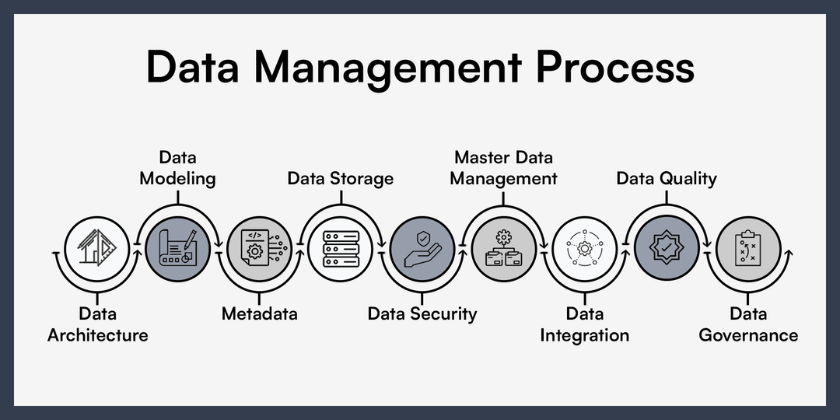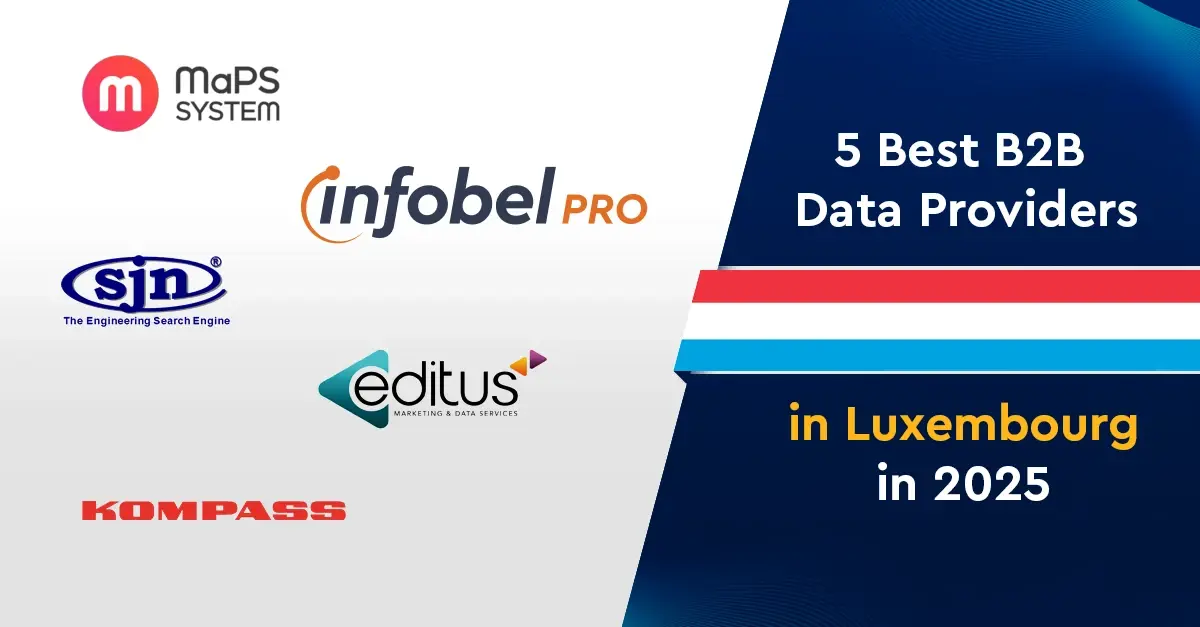Data management is the process of gathering, storing, and utilizing various types of data in a cost-effective, efficient, and secure manner. To make business decisions and conduct activities that will benefit the business as much as possible, the data management process aims to assist individuals and organizations in optimizing the use of data within the constraints of policy and regulation.
An effective data management strategy is more crucial than ever as businesses depend more on intangible assets to generate value.
Good data governance encompasses various tasks, policies, business processes, and practices including, but not limited to:
- Data creation, access, and updating for a variety of data tiers;
- Storing data assets both locally and across several cloud servers;
- Providing high availability, data protection, and disaster recovery;
- Using data integration in a wide range of applications, data analysis, and algorithms;
- Ensuring data security and data privacy.
These actions, and all other actions performed by the organization and its entities regarding the organization's data, as well as the capabilities of data management solutions, and compliance requirements, are all governed by the formal data management plan.
Why is Data Management Important?
Data is a strategic resource and a production input for digital goods and services in the modern economy. For example, car manufacturers can't make a new model without the necessary financial resources, and they can't make the model autonomous without the data needed for the onboard artificial intelligence.
Just the same, various enterprises can't make business decisions without access to adequate data, which makes data management tools and data management systems incredibly valuable to any business.
Data management is an essential first step in implementing efficient data analysis at scale, which yields significant insights that benefit customers and boost business performance.
Types of Data Management
Data management is crucial in an enterprise data environment and significantly simplifies and speeds up time-consuming tasks. These data management strategies include:

Data governance
A management plan that defines standards, data management processes, and policies that maintain data protection and security.
In order to maximize the value extracted for the company and its users, the process of data governance includes compliance with legal obligations, the implementation of internal processes and structures that enable them to be managed and used efficiently, and thus ensuring that companies meet their legal obligations.
Data architecture
Describes the structure of the business’ on-premise and local data assets and data management resources. Models, rules, policies, and standards related to the collection, storage, integration, and use of data are incorporated into this architecture.
Data modeling
Data modeling techniques and methodologies are used to create simple diagrams of the systems and the data contained in those systems. It consists in creating a standard and consistent model of data in order to manage it effectively as a resource.
Metadata
Refers to information that describes different aspects of a dataset and provides context. Metadata is data that provides information about other data.
Most common information like size of the file, its creation date, and the author's name are included in metadata. Managing metadata involves setting up rules and processes to access, share, link, integrate, maintain and analyze metadata to help companies make good decisions based on reliable data.
Data storage
A collection of methods and technologies for storing data.
The company must determine where it needs to store its data :
- Data warehouse - for clean and processed data
- Data lake - for raw data and bulk data
- Both - if the company manages both raw and processed data
Data security
Various points such as encryption, prevention of unauthorized access, protection from moving, corruption of data or accidental deletion of data must be implemented to ensure data security.
Data reference or Master Data Management
Includes all the tools, procedures and methods that ensure that a company's reference data is always accurate, up-to-date, and reliable.
Data integration
Involves moving and consolidating data into a single and accessible location. There are various methods to integrate enterprise data, from manual integration to application-based integration.
The most commonly used method is “ETL” — stands for "Extract, Transform, Load" and refers to a combination of processes that move data from one database to another or to a unified repository or data storage — typically a data warehouse.
Data quality
Refers to the consistency, accuracy and relevance of data. Data quality is especially important in direct marketing and customer relationship management (CRM), where data is an important resource.
Several actions can be integrated in data quality :
- Data discovery — the process of collecting and evaluating data from various sources to understand trends and patterns.
- Data cleansing — the process of detecting and correcting (or removing) corrupt or inaccurate data.
- Data integrity — refers to safeguarding data during its processing, storage or transmission so that it is not altered or destroyed intentionally or accidentally.
- Data enrichment — the process of improving the quality of the data an organization has by merging it with third-party data.
- Data Appending — this process is integrated with Data Enrichment, and consists of adding missing data to a database in order to improve its quality.
Data Management Risks and Challenges
Without a sound and well-structured data architecture, an organization may develop isolated systems that are challenging to combine, integrate, and manage in a coordinated manner. In addition, enabling data scientists and other analysts to identify and access pertinent data can be difficult even in organizations with better-structured data environments, especially when the data is dispersed across numerous databases and big data systems.
Many data management teams are developing data catalogs that describe what is available in systems and often comprise business dictionaries, metadata-driven data dictionaries, and data lineage records to help make data more accessible.
Migration to the cloud can make some areas of data management job easier, but it also brings with it new difficulties. For businesses that need to migrate data and processing workloads from current on-premises systems, transitioning to cloud databases and big data platforms can be challenging.
Even more so considering the cost associated with cloud services. To guarantee that data processing expenses do not exceed budgeted amounts, the use of cloud systems and managed services must be regularly monitored.
Data Management Best Practices
A thorough, well-considered management plan is necessary to address the issues associated with data management. The following best practices address the main data management difficulties organizations face today, while exact best practices differ based on the industry and type of data involved.
Define Your Data Strategy and Goals
As stated, data management requires meticulous planning; you should avoid diving in headfirst. Instead, start small by outlining your goals for your organization's data. This will help you in keeping the information that's relevant to your business objectives and prevent your data warehouses and data lakes from becoming messy and poorly organized.
Too many companies store too much outdated, useless data, which leads to clutter and poor management. Simply storing relevant data, on the other hand, keeps your data management software more manageable. Define your goals before using data. Your company's data goals will drive your company’s data management so you don't wind up with a lot of irrelevant data.
Build Strong Catalogs
Data quality is the foundation of strong data catalogs, and confining the data only to the information your business uses is a good way to enhance data quality. In addition, checking old data for accuracy is vital since it can become obsolete to your marketing and sales teams.
Your data management software should constantly remove outdated or stale data to avoid harming your sales and marketing automation, analytics, and other activities. Another way to assist your team focus on data quality in data management is to train all data-accessible team members on proper data acquisition and entry. Preventing erroneous data entry avoids future complications.
Eliminate Duplicate Data
You should have procedures in place to deal with any redundancy. These procedures should percent any duplicate data entry into your data management system, especially in the case of returning customers or lead magnets.
Even though many businesses don't consider this when first setting up their data management, it's crucial to design systems that permit data updates and audits when a customer repeats a purchase or opts in more than one time. In addition, precautions regarding redundancies and duplicate data are among the best database management practices to guarantee that your customer data is kept clean.
Keep Your Data Safe
Your company's data management must prioritize security and protection; this prevents a data breach or leak that might compromise your whole consumer base. Furthermore, in light of the General Data Protection Regulations (GDPR), established by the European Union and applied since 2018 established in the EU last year and coming to other countries soon, your company has to adhere to all current regulations to preserve the privacy of your existing customers and leads.

Using data management software and complying with the GDPR and several other laws can increase data security and protection. Create a data breach response plan for your company. Although this should never happen, having a plan is a smart idea.
Set Up Permission Levels
There's a very fine line between security and convenience when it comes to data management. On the one hand, authorized employees shouldn't jump through fiery hoops just to access the necessary data to carry out their daily duties. But on the other hand, your security should be an impenetrable fortress for anyone seeking information without proper permissions or clearance.
It makes sense to give people separate logins and access privileges based on their roles and data requirements. For example, more permissions are required for executives or team leaders who may need access to more customer data than analysts or sales personnel. This aids in maintaining customer data security.
So, instead of trying to establish general rules and permissions that can create problems, be overly restrictive in certain situations, or be too open in others, setting up multiple levels of permissions is the best possible option. In addition, it makes it easier for your teams to access the necessary data according to their position within your company.
Create A Data Recovery Strategy
Accidents happen, which is why your company must have an applicable and ready-to-deploy data recovery plan in place. Otherwise, losing access to all of your customer data, your marketing campaigns, marketing automation systems, and sales approaches may suffer tremendously.

Exporting your data to an external storage or transferring it to a cloud storage service like Microsoft Azure or Google Drive regularly will ensure that you maintain a backup of everything. Make backups of all your data so that you can restore it quickly and simply in the event of an emergency. Whatever your strategy is, make sure that it's practical for your company and easy to deploy if necessary.
Use Data Management Software
Finding dependable data management software is an important first step toward creating a successful data management strategy for your company. In contrast, a poor choice of data management software might lead to several issues. You need software that fits your needs, isn't overly complex, and offers numerous security features.
You need a data management platform that will provide precise information about your customers and accurate visibility into your leads. It should make the efforts of your marketing and sales teams easier by automatically enhancing and cleaning the data, allowing you to have the most accurate and comprehensive information at hand.





Comments